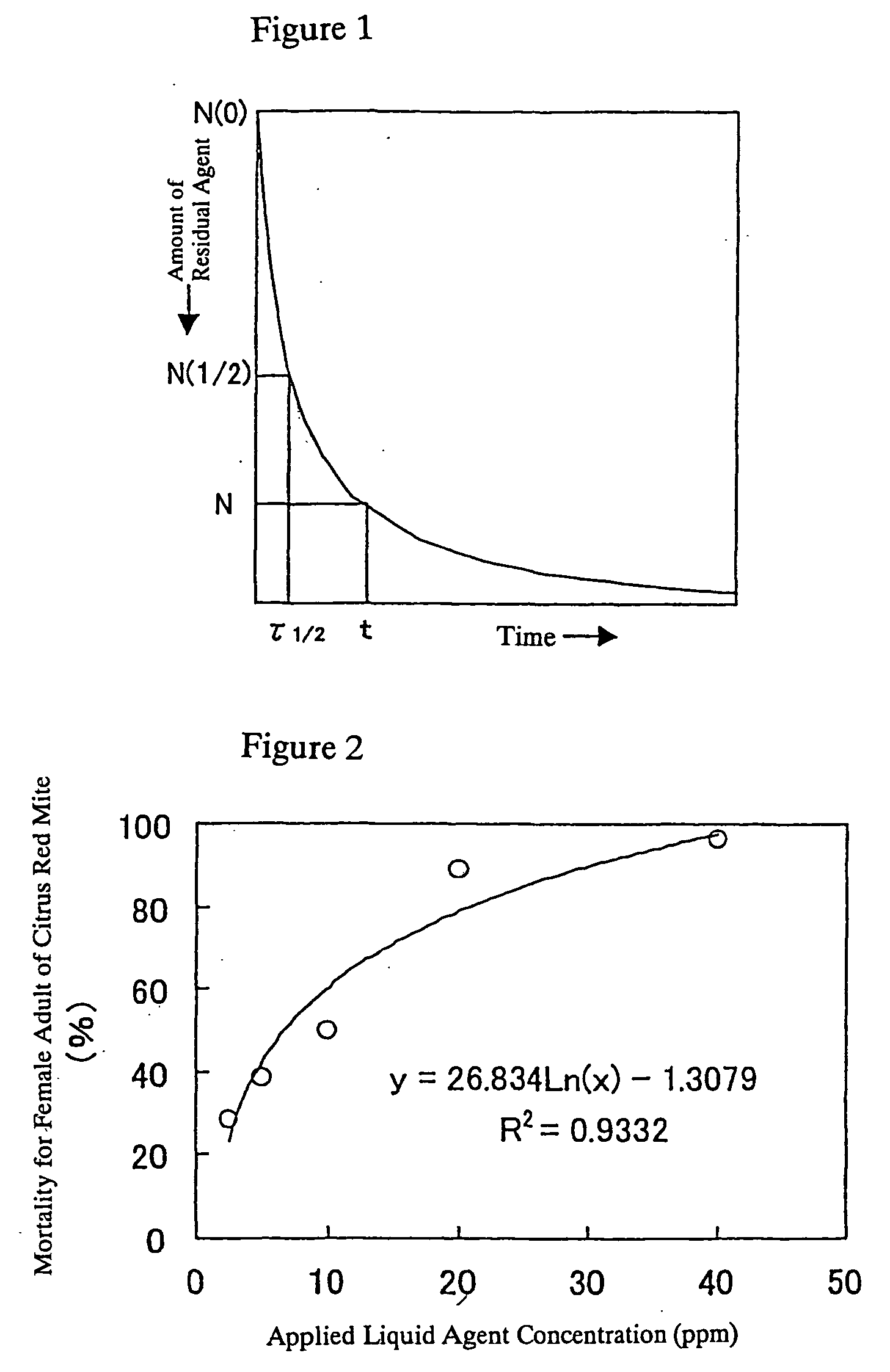Method of determining the practically useful application dose of pesticide, method of developing pesticide and method of indicating the performance of pesticide
a technology of pesticide and application dose, which is applied in the field of determining the practical useful application dose of pesticide, the method of developing pesticide and the method of indicating the performance of pesticide, can solve the problems of large equipment costs and personnel expenses, long time-consuming testing, and difficult for consumers to choose the most appropriate on
- Summary
- Abstract
- Description
- Claims
- Application Information
AI Technical Summary
Benefits of technology
Problems solved by technology
Method used
Image
Examples
example 1
[0087] Using the potency data given in the 1997 Agricultural Chemical Test Results Report, the practically useful application dose of NC-1111 (code number for an acaricide being developed by Nissan Chemical Industries, Ltd.) for female adults of the citrus red mite is determined. Sanmite.RTM. (a commercially available acaricide developed by Nissan Chemical Industries, Ltd.) serves as the control pesticide.
[0088] Bioassay tests are conducted using Citrus natsudaidai Hayata as the test crop. In concentration-mortality curve testing, female adults of the citrus red mite (Oiso colony, susceptible strain) are inoculated to tangerine leaf discs of 27 mm in diameter; the discs are placed in a constant-temperature room at 25.degree. C., and after 24 hours passed, all other than healthy female adults are removed. The specified liquid agent is applied using a sprayer, and the discs are placed in a constant-temperature room at 25.degree. C. The mortality is determined 24 hours after applicatio...
example 2
[0110] The equations and tables used in Example 1 were previously inputted in the respective cells of the spreadsheet program Excel.RTM. (Microsoft). In one worksheet, Tables 1, 2 and 3 and FIGS. 2 and 3 used in Example 1 were appropriately arranged. A spreadsheet was generated, having three lines for "name of agent," "name of pesticide," and "name of control pesticide" vertically arranged under these tables and figures, and also having a total of 13 columns laterally arranged for "name of agent" (overlapping), "application concentration (ppm) in concentration-mortality curve testing," "preventive value (%) corresponding to the application concentration," "application concentration (ppm) in residual activity testing," "number of days after treatment (days)," "decreasing constant," "half-life (days)," "effective preventive value (%) based on allowable damage level in residual activity testing," "applied liquid agent concentration (ppm) corresponding to the preventive value," "practic...
example 3
[0112] In developing a new pesticide, the practically useful application dose of a developmental candidate compound A for actual situation (represented by the useful application dose to ensure the duration and effect equivalent to those obtained by treatment with 100 ppm of fenvalerate.RTM. herein) is determined to be 50 ppm, from the results of indoor concentration-mortality curve testing and outdoor residual activity testing using third-instar larvae of the common cutworm (Spodoptera litura Fabricius) fed on pot-planted cabbages using as the control pesticide fenvalerate.RTM. in the practically useful application dose of 100 ppm, in the same manner as in Example 1. By employing the method of the present invention, the practically useful application dose of the developmental candidate compound A can be determined on Day 14 after the candidate compound was firstly synthesized.
PUM
 Login to View More
Login to View More Abstract
Description
Claims
Application Information
 Login to View More
Login to View More - R&D
- Intellectual Property
- Life Sciences
- Materials
- Tech Scout
- Unparalleled Data Quality
- Higher Quality Content
- 60% Fewer Hallucinations
Browse by: Latest US Patents, China's latest patents, Technical Efficacy Thesaurus, Application Domain, Technology Topic, Popular Technical Reports.
© 2025 PatSnap. All rights reserved.Legal|Privacy policy|Modern Slavery Act Transparency Statement|Sitemap|About US| Contact US: help@patsnap.com


